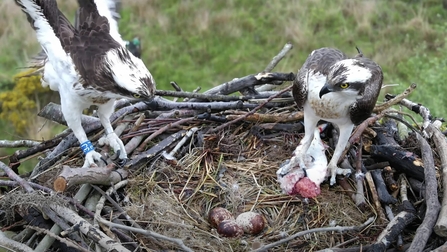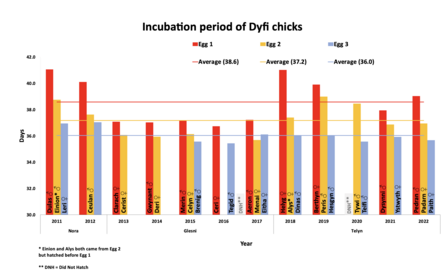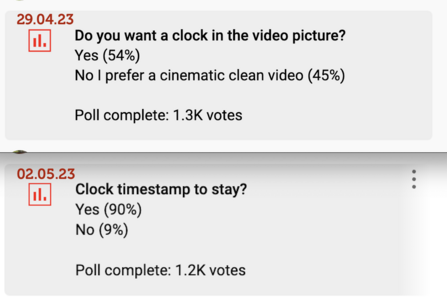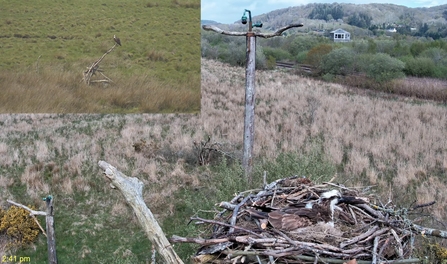
Shift change as Idris brings in one of three Allis shads in one day.
Blue 379

Shift change as Idris brings in one of three Allis shads in one day.
Not long to go now, we're three-quarters through the incubation period, the first egg usually takes the longest - around 38 days. The following eggs take slightly less due to the delayed incubation strategy and the fact the eggs are slightly smaller.
Here's a list of all previous incubation times...

Incubation times
What time is it..?
After years of requests for a clock on the live streaming so that people have a reference point to rewind to, we've implemented a 24-hr clock, bottom left of the picture.
Interestingly, after a week's trial 90% voted for the clock versus just 54% before they saw it.

Clock poll
So we'll leave the clock in place for the remainder of the season.
We've implemented a Picture in Picture function too - so that we can show you a thumbnail picture over the main view. Really handy when one osprey is away from the nest, on a marsh perch for example. Will be great once we have fledglings flying all over the place.
Just to be clear - we do this from DOP. You don't need to do anything except enjoy the picture(s).

Picture in Picture
2023 Intruders to date
We have seven high-resolution 4K cameras on and around the Dyfi nest.
These provide us with a detailed picture of the behaviours and ecology of our ospreys each year. They are also amazing at capturing visiting ospreys - even the ‘danglers’ that are only happy to show a foot or a leg before being ushered away by Telyn or Idris. That's often enough for a positive ID.
We get more and more intruding ospreys every year - this is a far cry from say 15 years ago when another ringed osprey in the area was a champagne-opening event.
As the Welsh population grows, the breeding territories act as an attractant to new, young birds looking to settle and breed in the vicinity of successful nests.
Male ospreys are ‘philopatric’, meaning they tend to return to the colony/vicinity of their birth to breed themselves - Tegid, Dinas and Aeron all good examples of Dyfi males that have returned to breed in Wales, all within around an hour’s flight from the Dyfi nest.
Over 99% of the world’s osprey population built their own nests, but we have several man-made platforms in Wales; a highly successful conservation tool to attract new birds, facilitating breeding dispersal and population expansion.
Here are the four ringed ospreys we have sighted already this season (there are many more that have been unrigned), including a video of all four of them:
INTRUDER (RINGED) LIST 2023:
1. Blue Z5 – 18th April. A 2020 female - Tegid's daughter from private north Wales nest (Friends of the Ospreys).
2. Blue 379 – 1st May. Female from Poole Harbour (2021), so our first two-year old of the season.
3. Blue KA5 "ROLI" – 1st May. Blue 24’s son from Brenig (2019).
4. Blue KC1 - 3rd May. A 2019 male from private north Wales nest (Friends of the Ospreys).
Hopefully 2021’s Dysynni and Ystwyth are on their way….
2023 Intruders so far